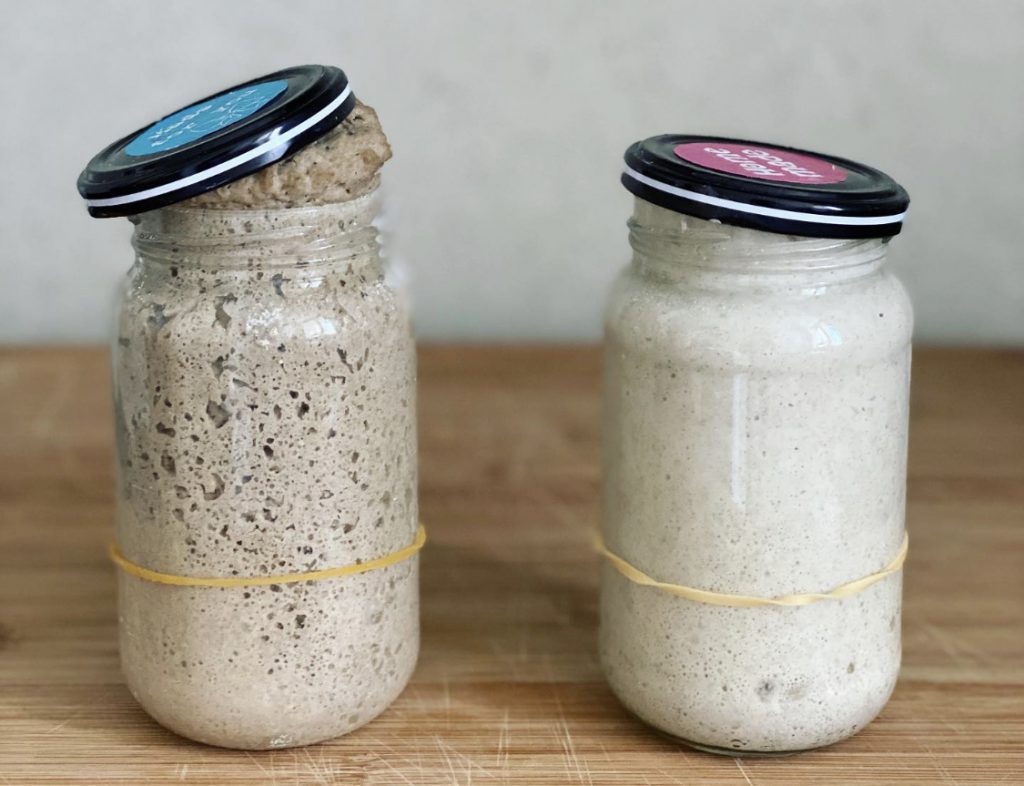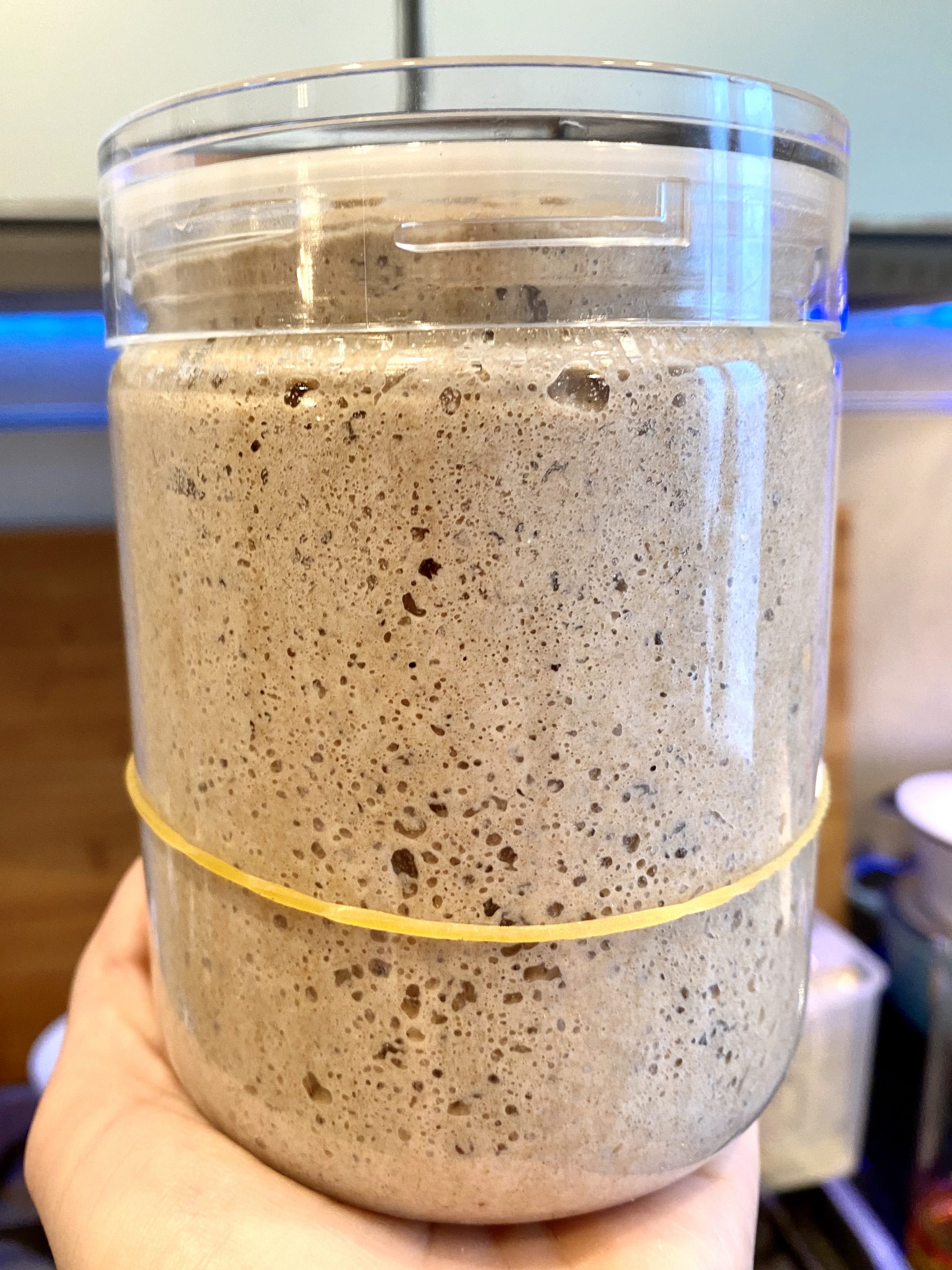The most hassle-free guide to starter care.
You’ve made a super strong sourdough starter. Here’s what it needs to stay alive and happy. Which is less than you might think!
Regular feedings
Your starter contains microorganisms, mostly lactobacilli and wild yeast. They need regular feedings with flour and water to stay alive.
“Regular feedings” doesn’t mean that you have to go out of your way to feed your starter all the time to bake once in a while. You can adjust your starter feeding routine to fit your baking needs.
If you don’t bake every day, you can keep your starter in the fridge. It can stay there for a week or two without feedings. Once you need it, you take it out, feed it and give it time to get active. You might need to feed it twice to give it back its strength, depending on how strong your starter is in general and how long you’ve kept it in the fridge without feeding.
If you bake more often, you can keep your starter at room temperature. Fermentation will go faster, which means you’ll have to feed your starter more often to keep it happy. Twice a day works well. This means that you’ll have lots of starter, so you either need to bake really often or you need to throw out some of the starter.
The right amount of food
A starter is a pretty resilient thing (don’t let people tell you otherwise). You don’t need to make it a science to feed it.
That being said, if you always give your starter too much or too little food, your starter and your dough won’t rise as much as they could. Thankfully, you can learn from other bakers’ experiences and follow their tried-and-tested starter feeding ratios to find the right balance.
The gold standard: A feeding ratio of 1:2:2
The 1 stands for the seed starter, meaning the existing starter that you’re about to feed. The two 2s stand for the amount of water and flour you add to your seed starter, so twice as much in this case.
Say you’ve got 30g of existing starter and you want to feed it with a 1:2:2 ratio. So, you add 60g water and 60g flour.
1 = 30g seed starter (as an example – this could be any number)
2 = 60g water
2 = 60g flour
Use these ratios as your guideposts, but don’t cling to them if they don’t work for you. Sometimes you might need your starter to rise faster to make it fit your day. Then use more seed starter. Or use less seed starter if you feed your starter in the evening to have it ready in the morning. You’ll still get amazing bread.




Hi, is it true that we must avoid metal spoon to stir it ?
THanks
Dear Mikk, I’ve heard that, too. However, I’ve used a metal spoon to stir my starter for several months and I didn’t have any problems. I switched to silicone spatulas because they’re a little bit more convenient to use.
I’ve had my starter for 8 years. I make a slurry with the water and starter, then add my flour and it’s all done with a bread whisk, which is metal. I wouldn’t store it in metal or plastic, though. I think the fermenting could eat at the plastic. I typically use mason jars with plastic wrap between the lid and screw band on the countertop and a crock in the fridge.
Good points, Regina!
To all fellow bakers: please, please, please do not discard! I have been baking sourdough bread 2 times a week for a year and have not thrown out any precious organic flour starter. After each baking, I just keep the remaining 2 tablespoons of starter in the jar in the fridge. The night before I need it for the next bread, I feed it and keep it in the fridge. In the morning I take it out and it rises much faster than it would if I just fed it in the morning. If I put the jar in a bowl of warm water, it doubles in 90 minutes to 2 hours.
Thank you for the advice on this site.
I agree. I rarely discard. It’s a pity to throw out starter regularly.
Happy baking, Marguerite!
My starter is about 7 or 8 years old. I was new to sourdough and a friend bought me a 100 year old starter from San Francisco. It arrived dehydrated. I began feeding it as per the directions and after a couple of weeks I noticed that it smelled the same as the one I started from scratch.
I struggle sometimes with the texture of my bread. I think it is often a cross between spongy and rubbery. I’m going to try your recipe, but is there something I’m doing wrong?
Hi Regina, a 100 year old starter from San Francisco, that sounds great! Have you noticed a difference to how your starter behaves? As for your bread, what’s the recipe you’re using? With gummy/rubbery texture it could be an issue of fermentation timing.
My starter is at least 50years old. I gave all my family a jar, but none of them kept it up. my starter sits in my fridge “separated,” and i only stir it when im ready to use it, about once every couple years. I have lost the original directions i was given 25years ago. i need some direction on how much to use for a loaf of bread. Any help is encouraged here !
bruce in Litttleton, Co.
A 50 year old starter, that’s impressive! Of course, happy to help. If you look at the recipes I shared, like the rye sourdough or the least complicated white sourdough ever, you’ll find the amounts of starter / levain you’ll need. They vary depending on the recipe and the size of the loaf you’re making.